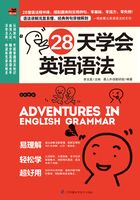
第3天 情态动词和助动词
3-1 情态动词
1.情态动词的概念
情态动词是表示能力、义务、必须、猜测等说话人的语气或情态的动词。常见的情态动词有:can(could), shall(should), will(would), may(might), must, need, dare, have to, ought to等。
2.情态动词形式变化
(1)没有人称和数的变化,第三人称单数的现在时也无变化。
I can, We can, You can, He/She/It can, They can
(2)有些情态动词有过去式,也有少数情态动词过去式和它的原形相同。
1)有过去式的情态动词有:
will —— would can —— could may —— might shall —— should have to —— had to
2)过去式不变的情态动词有:
must —— must(或had to)ought to —— ought to need —— need dare —— dare(亦可用dared)
(3)大多数情态动词后面可用动词的进行时、完成时和被动形式。
例如:can(may, must)be doing, can(may, must)have done, can(may, must)be done等。
(4)和助动词一样,情态动词后面也可以直接跟否定词not。现将情态动词的否定式及其否定式的简略式(简略式用于口语中)列举如下:
shall not——shan't can not —— can't must not —— mustn't
should not —— shouldn't would not —— wouldn't
could not —— couldn't dare not —— daren't need not —— needn't
3.情态动词的特征
情态动词表示说话人的语气或情态,本身有词义,但词义不完全,不能单独作谓语动词用,必须和实义动词一起构成复合谓语。
She must be your mother.
她一定是你的妈妈。(“must be+名词”表示对现在状况的肯定推测)
Everyone should obey the rules.
每个人都应该遵守规定。(“should”表示一种客观规定)